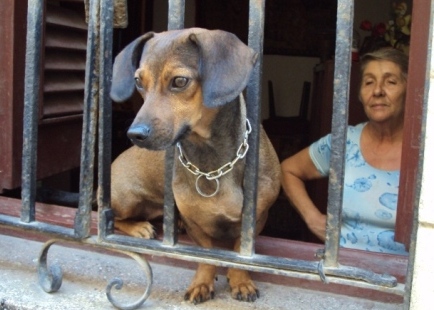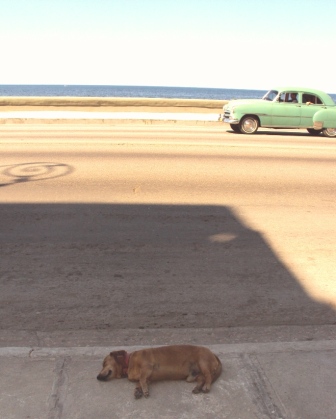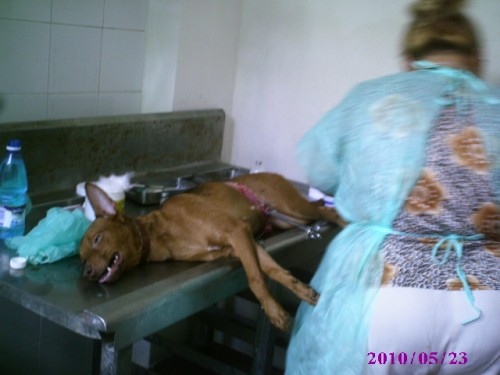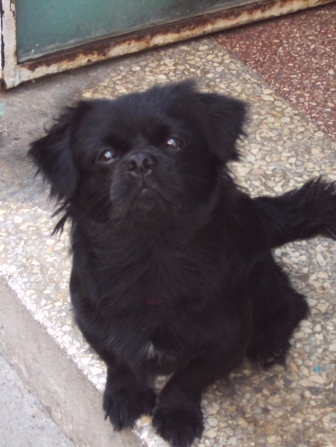Cuban Canines: The Dogs of Havana
April 2, 2012 by dykerr
Charmed as I was by the friendliness and wit of the Cuban people, again and again I found myself fascinated with a very different sort of Cuban native: the dogs. I’d never seen so many stray dogs on the streets before, and certainly never seen them so well behaved. The dogs would look hopefully up at you as you walked by, perhaps expecting a scrap from your bocadillo, but would rarely bark, beg, or follow. The Cuban people seemed to be similarly at ease with the dogs, occationally reaching down to stroke a stray on the head but otherwise offering little in the way of affection. The Cuban dogs seemed as amicable as their human counterparts, eager to make friends but hardly heartbroken if their advances were spurned. I found myself wondering about these dogs throughout the trip: How did they find food and water? Did anyone see to their health? Did anyone own these animals? What follows are my attempts to answer these questions.
Cubans have a long history of being dog lovers. While one may hear the street dogs referenced as being descendants of Columbus’s own canine companions, in fact the legacy of dogs in Cuba is far older, dating back to ancient colonists from present-day Mexico and other Caribbean islands. Today, most of the dogs one sees on the streets are the result of unions between these endemic breeds and their more “pedigreed” European counterparts.
I was surprised at how small and low-slung the feral dogs in Havana and elsewhere appeared to be; most of these dogs are mixed-breed individuals with considerable dachshund ancestry. The dachshund (sometimes called the “wiener dog” after its sausage-like body) is one of the most popular breeds in Cuba, along with boxers, Afghan hounds, and Dalmatians. Of Cuba’s estimated one million dogs, about half are thought to have owners. While providing enough food for their pets is sometimes a struggle for Cubans, the deep-seeded affection they feel for their animals means that even strays usually find enough handouts to eke out an existence. This concern for dogs may be a vestige of African Yoruba beliefs that inform much of Cuban culture. Dogs are honored in the Yoruba tradition for their usefulness as protectors, hunters, and companions, and this respected status extends to modern Cuban dogs. During my stay in the country, it was not uncommon to see Cubans reach down in the midst of a conversation to give a passing perrito a pat on the head.
It is perhaps this moral imperative to care for “man’s best friend” that explains how friendly and generally healthy Cuban dogs are, especially when compared to populations of strays in other countries. It also likely leads to the development of such organizations as the Association for the Protection of Animals and Plants (ANIPLANT), founded by Nora Garcia Gonzalez in 1987 to fill the lack of readily available health services for animals in Cuba. The primary focus of ANIPLANT is on sterilizing both stray and owned cats and dogs, with the goal of reducing the number of feral animals on the streets. This serves to lessen the amount of animals rounded up and euthanized by Cuban authorities, and also lessen the incident of tourists to Cuba witnessing dead or malnourished animals on the street. ANIPLANT’s services are provided on a “love offering basis,” meaning pet owners pay what they can for care, even if they cannot pay at all.
My research into the matter of Cuban dogs has shown that the warm hearts of the Cuban people extend to their animals as well as their visitors. The long history of dog loving in Cuba lives on. If the efforts of ANIPLANT and others prove fruitful, the dogs of Cuba can look forward to a happy and healthy future.
Sources:
http://www.folklore.ee/folklore/vol30/olusala.pdf
http://www.havana-unwrapped.com/dogs-of-havana.html
https://theaniplantproject.org/OUR_WORK.html
http://www.havanatimes.org/?p=25712
http://www.moon.com/blogs/cuba-costa-rica/dogs-are-havana-cats-are-naples
Leave a Reply
You must be logged in to post a comment.




